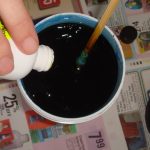Gelatin is a protein extracted from animal hides, bone, and sinew that belongs to the class of substances known as hydrophilic (“water loving”) polymers, which also includes other proteins, gums, starches, and a wide variety of synthetic polymers. Photographic grade gelatin is usually produced by an alkaline extraction process using bovine bones, although some acidic processes have been developed. Some special gelatins are also used that are derived from pigskins. The origin and quality of the raw materials used in the gelatin process, the conditions employed (pH, temperature, time, etc.), and the presence or absence of certain possible contaminants (e.g., mercury or other heavy metals, lipids, sulfur compounds, etc.) are of vital importance to the production of material suitable for use in modern photographic systems. In fact, photographic gelatin is much purer that that used in food applications.
 |
Gelatin solutions have the useful property of behaving as a liquid when warm and setting to a relatively hard gel when cool. When coated on a substrate and dried it is flexible and reasonably resistant to physical damage, but it readily absorbs water (as in the development process). Generally, the coated gelatin dispersion will contain some material such as formaldehyde as a “hardener” that serves to produce a limited number of cross links among protein chains that improve the physical characteristics of the coated material. The gelatin swells rapidly, absorbing water and dissolved development chemicals, but it does not dissolve or disintegrate at normal temperatures. These properties are essential in the preparation of a photographic emulsion, in coating it on film base or paper, and in the processes of development, fixation and washing.
Gelatin is more than a means of holding the sensitive silver halide salts in place on a on a film base, however. It is an integral part of the process and can significantly affect the properties of the final photographic product. Controlling the characteristics of the gelatin is absolutely essential to the photographic emulsion preparation, the process of coating the emulsion on the film base, the adhesion of the coated material to the film base, the wetting characteristics of the coated material in the development process, the physical characteristics of the dried developed product, and the long-term stability of the developed image. In a way, one could safely say that the gelatin is almost as important as silver to the overall photographic system.
In the preparation of a photographic emulsion the gelatin also acts as an anti-coagulant or stabilizing colloid. The silver halide formed in fluid gelatin does not precipitate out of solution but remains uniformly distributed throughout the preparation, ripening (see below), and coating processes. The gelatin is an important factor in determining the dispersity or range of grain sizes of the silver halide. By suitable regulation of the concentration of the gel, the temperature, and the rate of addition of the components, the grain size distribution can be controlled to meet specific requirements.
In the silver halide dispersion, gelatin molecules adsorb at the surface of the silver halide grain, surrounding the grain and forming a barrier that stabilizes the dispersion. The adsorbed layer also, in all likelihood, affects the radiation sensitivity of the grain and makes reduction by developers, more controllable. This is important in the development process and makes it possible to obtain desired results from a given system based on easily controlled parameters such as developer chemistry, development time, temperature, etc.


